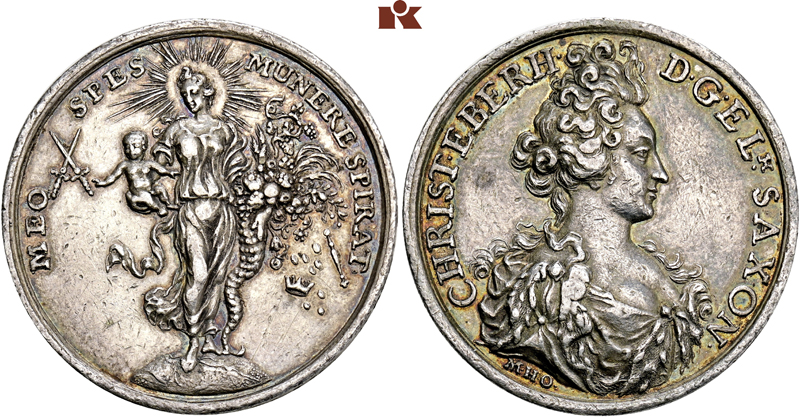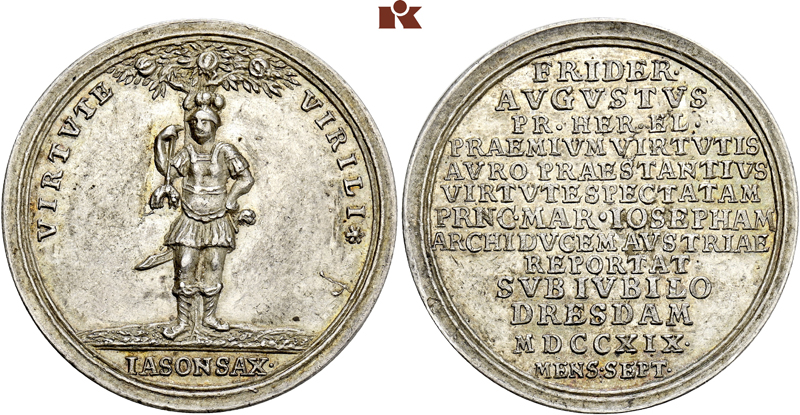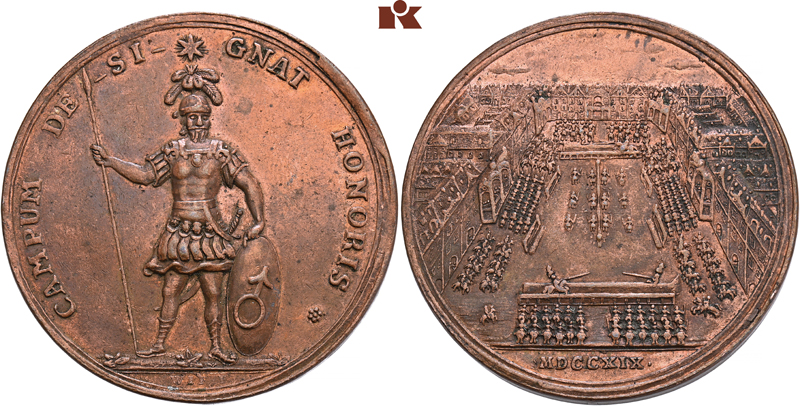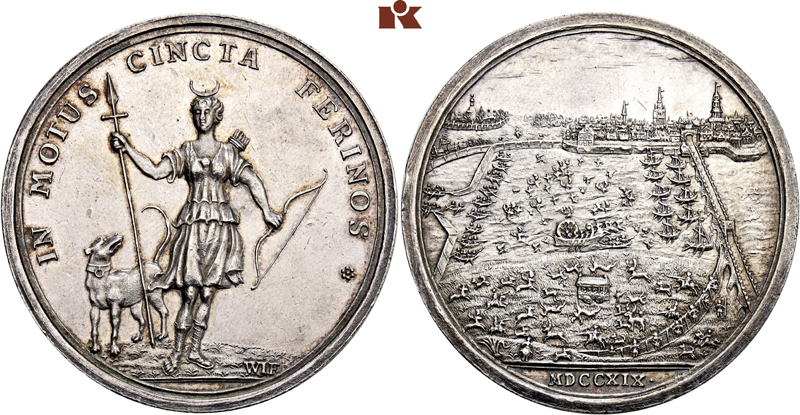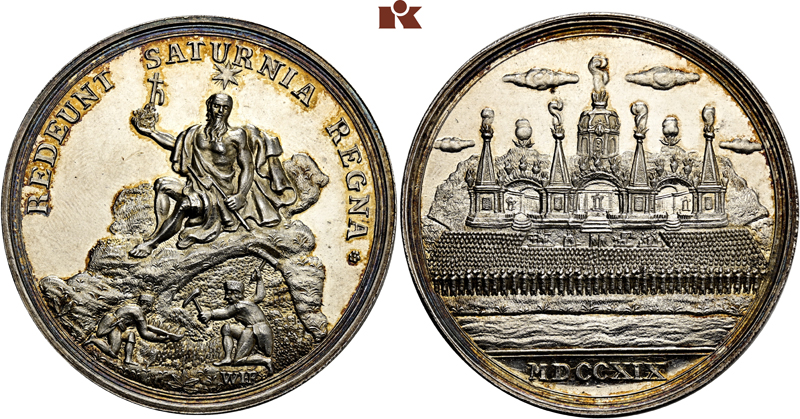The Wedding of a Century in Saxony
02. June 2023
On 15 September 1697, Augustus the Strong was crowned King of Poland. This was a triumph for the House of Wettin, and the Saxon Elector had been prepared to incur high costs and even a change of religion to achieve this goal. And yet, Augustus had even higher ambitions for the Wettins: from a purely hereditary point of view, marrying his son to the daughter of Emperor Joseph I came with the prospect that the Saxon Prince-Elector might win the Emperor’s title one day. The fact that the daughter of Joseph I had to take a back seat to the heiress to Joseph’s brother, Charles VI, who had not even been born when the negotiations started, is something we only know today. In 1719, Augustus could still hope that 2-year-old Maria Theresa would fall victim to one of the many plagues and childhood diseases out there. When we are surprised by the efforts, costs and pageantry of Saxony’s so-called Wedding of a Century, we should keep in mind that Augustus wanted to prove to the noble world that his son was worthy of the imperial crown.
Years of Preparations
We know from archival sources that Augustus the Strong had already been planning to set his son up for becoming emperor since 1705. To be on the safe side, he therefore sent the Prince-Elector on a years-long grand tour in 1711, to remove him from the influence of Saxon protestants. After all, the conversion to the Catholic faith was a prerequisite for this marriage. Frederick Augustus completed this step in 1712 in camera. Nevertheless, Augustus the Strong had to swallow a bitter pill: he, too, agreed to the Pragmatic Sanction of 1713, which established that the descendants of Charles VI ranked higher than those of Joseph I. However, people died quickly at the time. And treaties could be revoked. (Which actually happened in 1740 after Charles’ death.) In any case, Augustus’ consent cleared the way for the marriage: in March of 1718, the engagement of Frederick Augustus of Saxony and Maria Josepha, daughter of Emperor Joseph I, was officially announced.
The actual wedding took place on 20 August 1719 in Vienna. The celebrations for the Wedding of a Century were held by Augustus the Strong on the occasion of the bride’s entry to Saxony. Under the sign of the seven planets, the festivities almost lasted for the entire September of 1719.
Under the Sign of Sol: Saxon Jason
On 2 September 1719, the feast began with the bride’s entry on the bucentauro, a ceremonial barge inspired by the style of Venice’s ship of state.
A first highlight of an entire series of spectacular events was the feast of Sol, the god of the sun, on 10 September. It included a “theatrical” fireworks display. We must not imagine these fireworks in today’s sense of the word; we get a better idea of what happened by thinking of son et lumière shows, which tell a story with the help of light and music. The topic of the performance was ancient hero Jason’s quest for the Golden Fleece.
This was a clear homage to the Habsburgs. Emperor Charles VI had established an Austrian branch of this originally Burgundian order in 1716, after he had succeeded in asserting control over the southern, formerly Burgundian Netherlands in the War of the Spanish Succession. In 1716, he decorated the groom with this order. The depicted 1719 silver medal refers to this. It stages Frederick Augustus as Saxon Jason, who set out at the head of the Argonauts in his quest for the Golden Fleece.
The festive poem that was recited on the occasion of these celebrations has come down to us. Here is a small excerpt of its translation:
As his merit promised long before,
the Prince receives the Golden Fleece by great Charles today,
making him a member of the highest order
and thus fulfilling the symbolism of the fireworks.
The fate that had been destined for him since his entrance,
when he received the most beautiful fleece, the high bride.
What a lucky day! Today will become true what everyone prophesied;
a twofold golden fleece is now the prince’s prey.
He wears, Josepha, for your glory and pleasure,
one around his neck, the other in his chest.
Oh, may each link on this chain of order
bring its own special fortune to you.
To bring Jason, Helios and the Golden Fleece together, the organizers had to make a real effort. Fortunately, Aeetes – the ruler of Colchis, who had received the Golden Fleece from Phriux for saving him – was considered the son of Helios.
Under the Sign of Mars
For the celebrations dedicated to Mars, the organizers did not need to create such an elaborate theoretical basis. Mars was honored on 12 September with a grand tournament on Dresden’s Old Market Square. Such tournaments had nothing to do with the fierce fights of the Middle Ages. Instead, they were highly ritualized tests of skill, in which members of the nobility were supposed to demonstrate their mastery of various weapons. However, the participants apparently made quite a fool of themselves, as the accounts of historian Helen Watanabe-O’Kelly show. She writes: “Of the thirty participants in the joust, twenty-five were unable to hit anything at all. Of the hundred and eight participants in the tournament on foot, seventy-five similarly disgraced themselves.”
Our bronze medal depicts the location of the tournament with fighting men from a bird’s eye view. In the foreground, the joust takes place within the barriers. In this type of tournament, two opponents tried to lift each other out of their saddles using blunt lances. Points were awarded for how accurately the lance hit the opponent. In the middle of the square, we can see noble men on foot fighting each other with lances and swords. Other participants are waiting for their turn at the edge of the square.
What we cannot see on the medal are the many spectators crowding the windows. Some audacious lookers-on even climbed onto the roofs to get a perfect view of the spectacle.
This medal is part of a series of seven different types dedicated to the seven festivals of the various planets. The Norwegian engraver Oluf Wilf, who was employed at the Dresden mint at the time, created the designs. 200 silver pieces and an unknown number of bronze issues were minted from each of these medals.
Under the Sign of Diana
During two days of rest, on which “only” an opera or a comedy lasting several hours had to be coped with, the participants drew strength for the festival of Jupiter, the highlight of which was a magnificent horse spectacle, a so-called “carrousel”. Re-enactment performances, for example at Sanssouci Palace, give an insight into what such an event might have looked like. Afterwards, there was another day of rest and a Turkish festival with a procession of Janissaries and Italian acrobats, before Diana – the goddess of the hunt and the moon – was honored with a great hunting event in the Dresden Elbe Valley.
https://www.youtube.com/watch?v=9hktEZcPNHw
This medal gives an excellent impression of how the nobles hunted in the Baroque period. Even if beaters and dogs lost their lives time and again, the danger for noble hunters was rather minimal. The game was driven directly in front of their flintlock or lance. For this purpose, nets were used that were pulled tighter and tighter by the beaters. This caused the deer to move towards the Elbe river. Its only way out was the water, but there, too, danger awaited: additional “hunters” on boats literally slaughtered the animals, which were fighting for their lives.
What seems disgusting to us today, was a symbolically charged act at the time. Hunting certain animals was associated with particular privileges. This is the reason why – despite the small format – the medal features clearly identifiable deer with great antlers. These animals were part of the big game, which only the high nobility was allowed to hunt.
At the center of the image, we can see a ceremonial ship that was part of the event. It was used to carry Diana to the scene so that she may “personally” attend the hunt.
Under the Sign of Saturn
The feast of Saturn rounded off the festivities and was an absolute highlight. Saxony celebrated its rich supply of precious metals – after all, the favorable position of the territory was mainly based on its abundance of silver.
Artists had built a temple of Saturn for the feast, not in the city of Dresden but in the “Plauenscher Grund” area, which was in the countryside at the time. The building was crowned with a massive statue of Saturn, which is depicted on the medal’s obverse. Saturn holds a crystal in one hand, in the other hand a ceremonial axe of the type that was used in miners’ processions at the time.
The arches of the impressive monument are reminiscent of the entrances to mining tunnels. This is where the noble audience sat to watch the performance of the miners, who had come from all mining district of Saxony. In a nightly procession, 1,600 people paraded with torches.
Very small – between miners and the temple of Saturn – various tools and sceneries can be identified that are part of the process of extracting and smelting metal. In this way, the engraver alludes to the 170 images that the miners presented to their audience as the most important steps in mining.
One of these steps is the minting of coins. To demonstrate this, a small minting press was moved along on a wagon in the procession. It produced tokens that were distributed among those who had gathered.
Recent research suggests that Augustus the Strong’s Saturn festival had a significant influence on popular art. The decorations of this feast are believed to have inspired the production of various typical items of Saxon Christmas culture such as the “schwibbogen”, “pyramide” and “bergmannszug”.
The total cost of the festivities is estimated at about 6 million talers. This means that Saxony went into debt for decades. And yet, the increase in prestige that Augustus the Strong had hoped for did not materialize. Little Maria Theresa survived and it was not Frederick Augustus but her husband Francis Stephan of Lorraine who was elected emperor. By the way, the Polish crown did not become part of the Wettins’ inheritance. Although Frederick Augustus succeeded his father as King of Poland, he had to defend his crown against anti-king Stanislaus Leszczyński, who had the support of France. In this situation, he might have preferred to spend the 6 million talers on soldiers that had gone into his wedding feast.
Secondary literature:
Claudia Schnitzer, Constellatio Felix. Die Planetenfeste Augusts des Starken. Dresden, 2014.
Monika Schlechte, Recuil des dessins et gravures representent les solemnites du mariages. Das Dresdner Fest von 1719 im Bild. In: Chloe 15 (1989), pp. 117-169


